Rev., Dec 3-4-5-6, 2021.
As things accelerate, I have been thinking again of Gerard Nerval’s Aurelia, if read as a work of mesmeric art. As a result, I am going to go through my notes, and see if I can begin to shape his experience according to the hermeneutic of my dream structure models.
Early on he describes feeling enfeebled and unrecognized, and “forever doomed to despair.” He then sought out in dreams, which mocked him, so that he can only give distorted images, reconnection with this dream world. He seems to have thought that his salvation, or heaven, in fact, was in this dream world. Where was it vis a vis his consciousness? He describes his “mental struggle.”
At the beginning, he is fairly rational, but the key thing is he describes his encounter with an angel. As per an article by Allan Beveridge, The madness of Gerard Nerval, there remains a debate over how much he romanticized his madness, or by reading it that way countered it, and by the fact that in the modern era both Jung and Laing continued to offer the idea that madness can be a kind of insight or deep truth if engaged by the self. You know my view. It is a folk theory, not a medical theory, but I hold it fast. “Madness” is a literary conceit signifying an intensification of rational thought into an irrational mania by the working upon it by exploitation fueled by feelings of rage and revenge, and is at the opposite end of the pole of well-being in the mind from mental illness and schizophrenia, which is not about concentration, but about being pulled apart. The one is a vertical rush to a manic peak, the other is a falling away into the void, torn apart by Psallictus. I have since day one dismissed any movie or book which in my view attempts to glamorize and romanticize mental illness, as, indeed, I held a long grudge against, for example, Ken Kesey’s ridiculous ideas in One Flew Over the Cuckoo’s Nest. I have written about this often, it is an issue of constant concern this past year. There is, in fact, in my view, no argument. If Nerval was, in fact, institutionalized several times, sometimes by concerned friends, that alone indicates his mental illness, that he felt like he was coming apart. Therefore, I am not that interested in his personal apparently self-remediating rationales and fantasies of visionary insight, and only in the incidents that strike me as of a breakdown sort. Moreover, he starts Aurelia by saying, “dream is a second life,” which I agree with, and, indeed, I also believe in the flip or the Big Sleep meaning that in his manias he flipped dream over onto life and in fact may not have known what was dream and what not, and for that reason the only point of interest is trying to place where Nerval was at various times in his mindmazings, to see if there was a way out, and, as he lost, how he lost it.
Right at the beginning, he gives some sources, Swedenborg, the prototype for angel sightings. As for Dante, and perhaps Apuleis, both are of interest as they did in fact visualize hells on earth, and thus opened the human mind to a state of “epigogic” comprehension that the modern mind by and large restricts entry to..Nerval here visualizes hells on earth. Anyways, things proceed, there is the dalliance with a possible new love, a woman who seems positively alarmed at Nerval’s attentions.
But, for the street scenes, walking along one street he saw a shop sign with a number which was the same as Aurelia’s death year, then a woman was in the way, she looked like Aurelia thus he has a twinfire incident, based on false equating of appearances, so, he claims to have felt an omen of her death. Seeing omens, though this sounds like an example of Jung’s synchronicity, is an aspect of the initial in-turning of the first stage of mesmeric hypnosis, in vigilogogy, dreamy awakeness.
He then argues that a dream he had that night confirms it. He wanders through a large house with many rooms and it seems to be a composite microcosm of his old school and of the world, and then after getting lost a few times comes to a gallery. From the gallery window, it appears, he sees up above in the courtyard out the window a creature of disproportionate size, androgynous, fluttering overhead. Then, it exhausts itself trying to take flight, so “plummeted into the center of the dark courtyard, snagging and bruising its wings.” It was rosy colored, and the wings were like rainbows, it wore a long robe, and reminded him of Durer’s Angel of Melancholy.
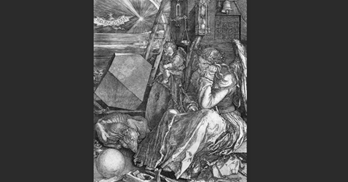
but It caused him to shriek, and then awake “with a start.”
Who is this angel?
First, clearly, it is a turning point angel, and an angel that introduces him to a dark time. He compares it to Durer’s Melancholy, but that seems to be a formal comparison based on the fact that the angel has long robes on (which likely contributed to its loss of coordination). It seems more likely that this angel is Abgrunde, Apollyon, the angel with the key to the bottomless pit, a different Durer,.
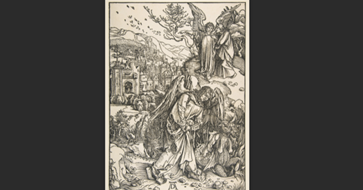
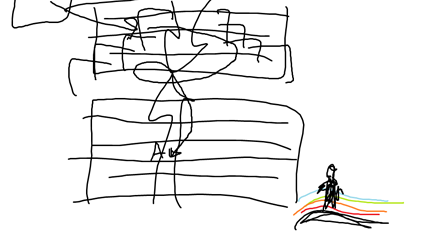
if, in the “frustum”, his mind empties out vigil-hypnagogic space, that leaves him with the power to by the touch of the emptying out rattle at Abgrunde, to then cause him to spin up over the voided center above. Nerval is then in classic lattice position, below, but because of the emptiness of his frustum of it, he is more proskynetic than normal, it might be that he froze into a state of being pressed down, paralyzed, and then it was the as if hydraulic pull of that shock that pulls Abgrunde up into the High Light to become as if the demon figure of that presence; but, then, whatever he might have hoped for it, it begins to struggle, tumble and fall, a great black form crashing through the center of his consciousness, and Ephialtus appears, to cause him to sit bolt upright in bed, survivor of a nightmare. This is, then, for all his wanderings, a classic “nightmare” where a demon appears, and then crashes in on you, to force you to pay attention. But the big difference here, since he mentions that next day he started doing rounds with friends to say goodbye, he took this as a premonition of suicide, and thus set in motion plans to do so. It is then also a suicidal ideation nightmare, given its great empty voidedness by the nature of the empty frustum through which it falls.
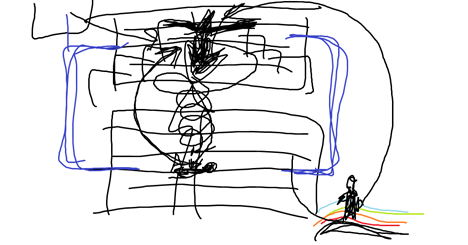
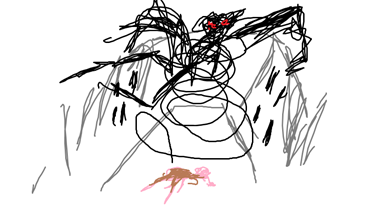
the black angel 12 4 21
On the overall sighting, seeing it above, knocking about, being knocked down by the too narrow containment of the courtyard, it might be black. But he says that it is reduced, and then has rainbow wings. This could happen if the core were hollowed out, and then emanations from hells on earth could more easily rise up, to participate in the wingspan.
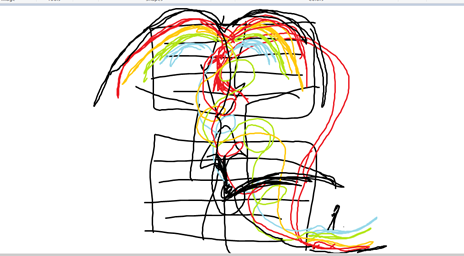
this graph argues that the angel has a connection to Abgrunde, and, for that, is in fact formed out of the emanations of hell on earth. The reason that it is gangly, and has lost control, is that its wings are unhinged layerings of the mists of the hells on earth. Each color of the rainbow exceeds the last, and if the body is red then he is a creature of Pandemonios. If made of emanation, this also makes of him more a demon than an angel. Its labored movement suggests the spindly spiderwalk ethos of demons. Therefore, it scares him because a demon.
Indeed, Alfred Kubin pictures this gangly, somewhat out of control flying demon, he does not picture a being of flesh, with a robe on, but a being made out of robe, a famulus, then, coming out of a figment, and related to the beach figment called up in Whistle and I’ll come to you (1968).

as if a type of Delacroixs image of Mephisto’s demon,
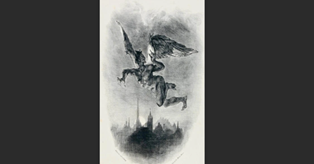
these are demon-angels of reckoning, which likely haunted poets and artists alike. He then has further social interactions as “the fatal hour,” that is, his intended suicide, comes. He then sees a fata morgana vision of an emptiness seen from a hilltop, and thus rereads his sighting of the angel as in fact his version of the devil tempting Jesus in the desert.
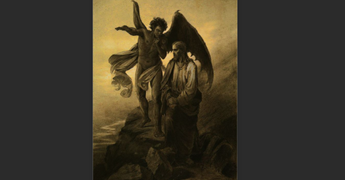
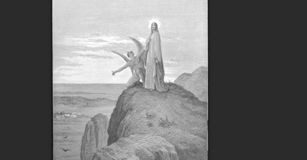
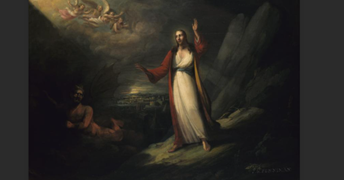
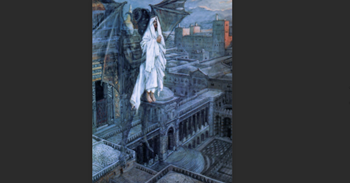
Nerval rationalizes all this as proof that he had made contact with the dream realm, a mirror realm adjacent to his Paris. He talks of living in this double aspect, where on one level, meaning was one thing, but on another, everything had a double meaning. Further elaborating on the nature of the relationship between his world and the spirit world he argues that spirits can “take on the bodily shape of an ordinary person,’ and thus act on us. This is what he thinks has happened here. A psychopomp showed up to lead his spirit in and down, but then it messed up, and now he is fallen under the influence of Abgrunde, with her key, and sponsor of suicides too. Clearly, this is the precipitating event in his descent into mental illness. This is the first time a suicide ideation takes on a nightmare form that shocks him awake. This fallen angel is the suspension of his disbelief in the world, now those illusions crash down, he wants to kill himself. This then precipitates the first breakdown that gains the attention of the officials. Overall, too, Nerval’s description of the event amounts to “visual wisdom” as I think that a breakdown will look like a nightmare whoosh, the format of his tale.
And then it comes on him. After Mardi Gras he strips naked in the street, lead by a star. He roams, he puts his arms out, what he is waiting for his star fusion, based on the fact that his body is “magnetically attracted into the ray of the star.” He then feels the magnetic pull, puling him up. But then the cops come and though he feels quite tall and flooded with electrical forces, they take him away. When a man shrieks at seeing a black angel fall onto him, causing him to start awake; when he then strips naked and runs through the streets following a star which he thinks he must merge with to bring the virtus of its magic down, this is a breakdown event. Kubin’s drawing captures the abject hysteria of it, a frail bony, small penis man, trapped in a dark street
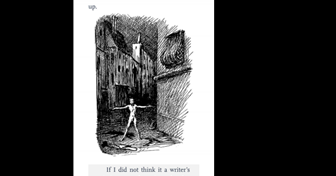
formally, this pictured episode feels connected to the previous vision of the angel, as if a reverberation, my scirpograph
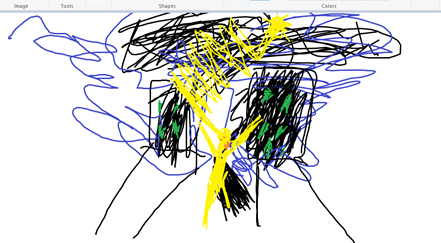
Star dance 12 4 21
Now on his camp bed in the asylum he describes a euphoric fata morgana vision, which I am not that interested in. It is a plateau of dream or waking, dream or daydream, to project one’s frustrations to a place in the brain where they can be overcome. He then apparently suffers a recurrence of this nightmare at the same time for a few nights, what I call a timestamp imp (and, indeed, I have been being attacked by the 2 and 4 o clock demons the whole week after my Friday crisis). Last night he was seeking union with the star, this time, same time, lightning strikes him down.
Kubin’s drawing is, in fact, a rendering of the “Umwelt” search for self-talismans, as a way to recover from nightmare, and rise up. The stripping bare is perhaps typical of this state, the wandering too. The fact that he is under a star, following the star, then imagines himself finding the star, which then replaces the dark angel above him, all of this echoes on the fact that I argue that in this state of suspension, unsure or what is awake or not, that the High Light zaps one with lightning, to make the point. Blake also believed, in his Robert, that messages from his dead brother came from a shooting star striking the instep of his foot.
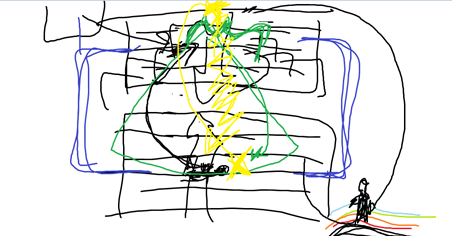
This famous first breakdown, then, is rather classically contained inside nightmare formations. The transformation of the haunting form from a melancholy angel to a star indicates the degree to which he is in flux between top and bottom of the mind. This sighting, in a courtyard in central Paris, sets up the rest of it, in its psychogeography.
Then, his dream-mind wanders out into ambience. Movies or books when the hero ventures out of France into Germany are rare. Of movies only The Girl with the Motorcycle (1968) registers in memory. Here, however, Nerval has an intense relationship with Germany, due to the fate of his parents. Now he is transported to the Rhine, there are menacing crags, but on top a cheerful cottage. He then felt that this place feels so much like home it must be the home of my maternal uncle. Though vague about how he ventured to the Rhine, I place this first foray into some redoubt of paganism downhill from his primary concerns . It is Flanders, the homeland of his maternal uncles. One of them, a hundred years ago, was a painter. He seems to have had a problem finishing work, unfinished canvases hung about, but one was about the fairy of the Rhine (Lorelei?). Then he is told to go take a nap, does so, but then a bird, the soul of his ancestor, spoke to him from a clock on the bedtable, a clear famulus haunting. As I see it, this is tracery over classic dream formation dynamics, movement across the Luor (the in-between) into the Forest of Lost Thought and the Village of Dreams, the cottage is Kienholz Cottage, she will show the way. The fact that it seems to exist pre 100 years ago ads prototype space essence to it. The bird spoke not 100 years ago but in a further advanced state of time relativity, when there was no difference between then and now. Even more amusing, the bird tells him about a portrait of a woman, a German woman in costume leaning over the river, picking flowers. Who the painter is, maybe Schalken, others, is of interest. The purpose of this journey to a place where he had extra backup of maternal relatives outside of France is to introduce a personage met at a party. On the wings of the philosophical debate about the nature of certain posthumous states the whole sequence escalates and expands to a high fata morgana floating over all. At one point he breaks to visit a village and Kubin’s rendering of it is a classic camoflague form of a fata morgana, all of this then is more reverie by the Sleeper cast into a high minded place.
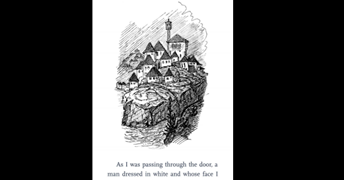
This whole reverie of a perfect palace also included the girls. The purpose of this fata morgana it seems was for him to commune with his maternal ancestors to then pour through pictures of them to at last meet a personage who confirms for him that if he can meet up with all of them in this dream that means that is a dry run for the afterlife, and so, there IS an afterlife, and IS a god, and there IS more than utterly nothing after death, and Nerval takes great solace from this. But, then, further on, he comes upon a woman, she then grows so large that the garden in whole takes on her shape. Her face and arms were imprinted on the purple clouds of the sky. This seems like a revisiting of the angel. He sees a nude bust in the garden, and it seems to indicate to him that this is another premonition dream, and now he is aware of the fact that Aurelia has died.
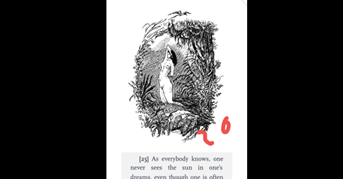
The only way to work this out dreamwise is to accept that Nerval is not quite working with a modern sleep science model and so his first foray across the Luor into the ambient redoubt of Germany, he just did an introductory meander, to feel out the situation, ending up in the Great Bed.
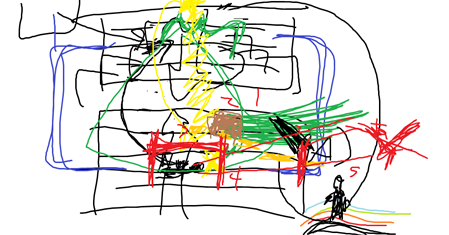
but, then, he backtracks and then retraces his steps over the same terrain a second time, and this involved his discovery of god and the afterlife, secrets of life. But then, the bust, this is another talisman form, another link on Orion’s belt, and thus he is soothed. Only, then, in a pattern repeated here, for it to be immediately wrest away by his restlessness.
THEN he goes down in in “syngogy” (green, unsure if awake or asleep) searching out his umwelt talismans, of which the news of eternal life is a big one.
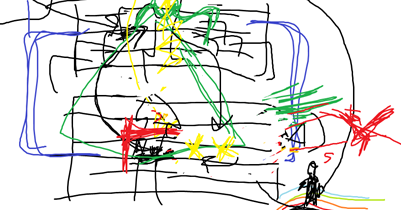
then the second premonition is that Aurelia is dead, this, I think, triggered another ephialtic leap, or bounce out, to “epigogy” (red, seeing the monsters), whereupon he sees all the godlike figures, again in a kind of fata morgana dream form. He is working in a binary way, so it makes sense that he finds two talismans, both in the form of knowledge, and so the shock of the finding causes him to bounce out, as opposed to leap up out of that phase, to then by seeking to comprehend more, experience through a vector a fata morgana pull that inscribes over the former spot of the ancestral village and cabin a new mansion where he decorated all the frescoes. And the really odd thing is that after making this bounce out, to come in over the space of the house with the unfinished paintings, he now experiences the now of art and sees a portrait of Aurelia, surrounded by a court. It seems he painted it, coloring it with tones extracted from the juices of flowers and weeds. The fact that she has a wheel under her, surrounded by gods, makes me wonder if she is not here depicted as nemesis,
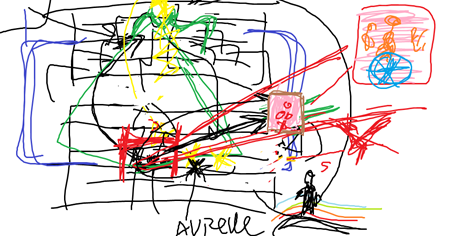
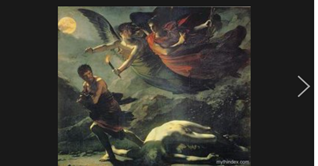
I believe that this painting is a Pinkie painting, the Rightful Red Herring.
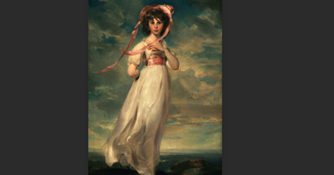
In the fashion of the time, it is also a “pinax”, that is, in a situation where everything is falling apart, he holds an image of his ideal in his mind, it is a common trope. The fact that he paints it with flowers, accords with conventions at the time
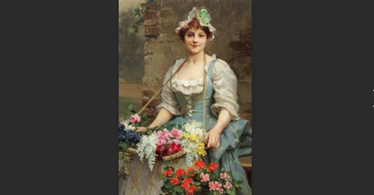
since the picture is not described it might also partake of the legends of unfinished masterpieces (re Balzac), in any case, it is for devotion to a lost love. As such, it is a work of art as a half-life of the loved object, depleted, but compensated for, by a measure of possession.
He resorts, in this place, revisited, to make art, he worships the idol of his love, he tries to sculpt her in clay. These are also not described, he could be thinking of literally any of a thousand sculptures of the time.
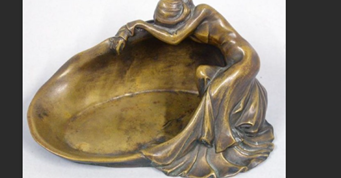
Then, he is given paper, and covers them with thousands of drawings, and “tales in verse” and “inscriptions in every known tongue,” resulting in a history of the world intermingled with memories of of my studies. He admits this is all “private preoccupations,” a nice phrase encapsulating culture. He is even goes ancient, saying that he gets his ideas from genius using talismans, including the Stones of the Sacred Table, to then paint a painting of the seven Elohim who divided the world. He then explains this history of the world, and the pantheon includes undines, and AFRITES, partly made of earth. He talks of wars of the spirits that lasted thousands of years. They took place on the Mountain of the Moon, in Ethiopia. This goes all the way to Kubin’s two drawings of the people exhausted by these wars.
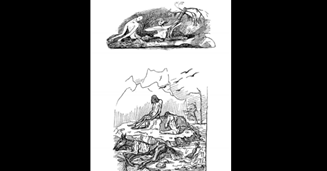
Then there is a plague, then Orion cleanses the world by pouring cataracts down, the earth spun backwards, the seas overflowed, the floods filled the sands and the tombs of Egypt. This almost sounds like scripture, with three of the Elohim taking up a place on the highest mountain of Africa, but wow, it just goes on. Then, once again, it turns dark, with which it all comes back to the talking bird.
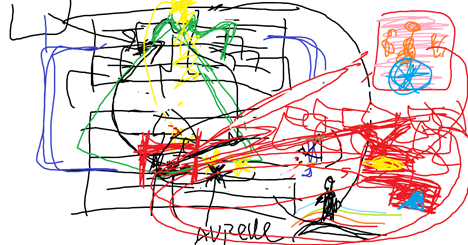
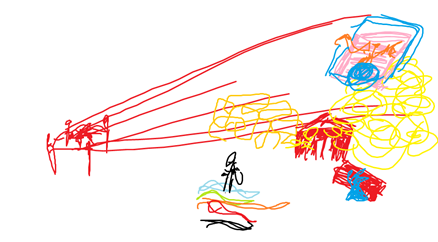
Nerval’s Flemish Rhineland Retreat 1 16 22
What is going on here? There is a type of dream I term the Night Mirror. What happens is that if one assaults sleep repeatedly, but always fails to get to sleep, one ends up with most of the night having been spent in insomnia. Each time one besieges sleep and fails to get there, it is as if a slash, struck against sleep, instantly forms a mirror, and as the strobe builds up, a zigzag of lightning strikes, but in the forms of mirrors, builds up, and this then spins the mind out into ambience, and one then comes up into wakefulness almost in a mania singing an anthem or literally waking up talking out a great rehearsed speech. That is the Night Mirror, and if the waking is in anthem or self-talk, depending, I call it a Morning Storm (which can, however, be good to bound you out of bed, busy).
This can become even more manic if at several points in the whole recursive spinning, going over and over the same ground as if a storm that has stalled over the locality, if there are moments when you think you are asleep and they turn out to be awake, or vice versa, this CAN (as been happening this past week, I think under the side effect of albuterol) become quite manic. As one becomes frantic to sleep, a dream may have an intense half-wobble element that strikes one as if awake, intensely. It this is also instigated by a timestamp demon, or bed imp, like the Demon of Four O Clock, the spin can be more intense. That is, there is turbulence.
But, in Nerval’s description, what I think is happening is at that spot in the dreaming brain where he first visited his Flemish ancestors, he fixated, and then it circled round to overwrite as a larger house, and then circled back around to become a palace, and a garden, and then he made murals over the whole place, and then he saw portraits, one of Aurelia, and then he tried sculpture, and then the thousands of drawings flowed out all over, all of it in its involution and inosculation then sinking in on itself to a clairvoyant core, which goes entirely occult, tracing out, almost like Blake, the history of the Elohim, this is a Kubin portrait of Elohim
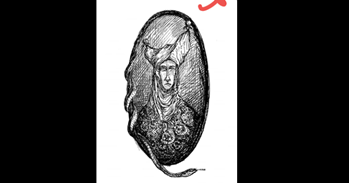
he is basically, in a formation as I have not previously described it, caught in a hyperloop, and he is circling over and over and over and over and over the same ground again, caught then in a Night Mirror mania. In the abstract
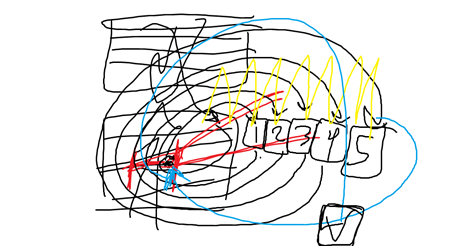
This dream form, of course, showed up in the “Full of Stars” formulation of what the Big Brother monolith was in 2001, it does not strike me that Clarke in his sequel made much headway in determining that. But they used this figurative form of the mis en abyme, which in my view is a recursive function, that stalls or gets stuck, and just rains and rains, and in each return the quantity becomes greater and greater until it seems almost infinite, at which point the main thrust exhausts itself as it all gets away from him.
Thinking of all this, and that in this manic state things really are “synchroetherrhoe”, everything all at once flowing together, I came across a sculptor this morning, and let loose on it.
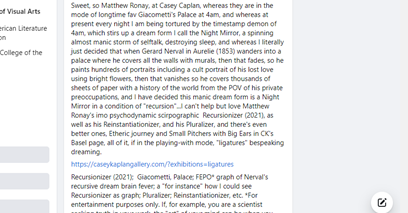
“Sweet, so Matthew Ronay, at Casey Caplan, whereas they are in the mode of longtime fav Giacometti’s Palace at 4am, and whereas at present every night I am being tortured by the timestamp demon of 4am, which stirs up a dream form I call the Night Mirror, a spinning almost manic storm of selftalk, destroying sleep, and whereas I literally just decided that when Gerard Nerval in Aurelie (1853) wanders into a palace where he covers all the walls with murals, then that fades, so he paints hundreds of portraits including a cult portrait of his lost love using bright flowers, then that vanishes so he covers thousands of sheets of paper with a history of the world from the POV of his private preoccupations, and I have decided this manic dream form is a Night Mirror in a condition of “recursion”…I can’t help but love Matthew Ronay’s imo psychodynamic scirpographic Recursionizer (2021), as well as his Reinstantiationizer, and his Pluralizer, and there’s even better ones, Etheric journey and Small Pitchers with Big Ears in CK’s Basel page, all of it, if in the playing-with mode, “ligatures” bespeaking dreaming. https://caseykaplangallery.com/?exhibitions=ligatures Recursionizer (2021); Giacometti, Palace; FEPO* graph of Nerval’s recursive dream brain fever; a “for instance” how I could see Recursionizer as graph; Pluralizer; Reinstantiationizer, etc. *For entertainment purposes only. If, for example, you are a scientist seeking truth in your work, the “art” of your mind can be when you just play with it, a point often missed. Finally, GREAT anti-somnambulism quote from Carolee Schneeman, chop the sofa into bits! Exactly.”
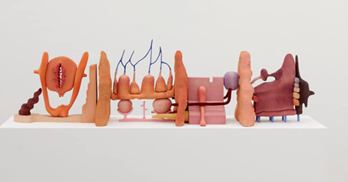
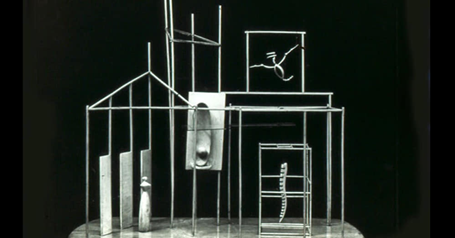
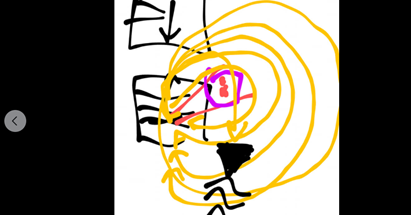
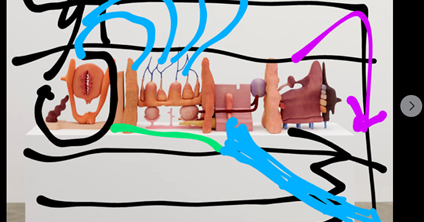
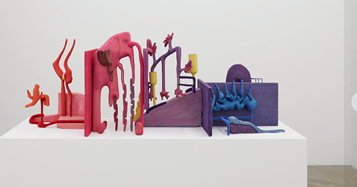
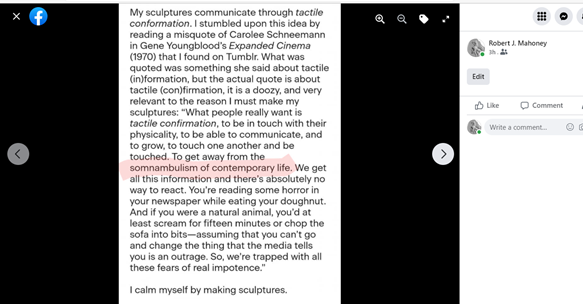
The fact of the recurisiveness of the images might mean this is lucid dreaming, fixed on one form, to travel more aware of itself through. That said, this kind of recursion demands that there is a reverse agency trend in it. That is, as it goes on, each successive layer gets more real than the last. An important point is that one in syngogy has experiences which one is unsure is it dream or reality? A few nights back I felt a fizzle left of my ear, this then visualized as a flashlight in the dark, moving toward the door of my sister’s room, 2212, circa 1965. It is because I think the opening fizzle had happened in reality, for real, that made this vigilogogic. This is standard stage one mesmerism, the in-turning.
But, then, last night, I had by far the weirdest of these experiences. I woke up at about midnight to a spark. The small halogen lamp on the bedtable was burning. This was caused by a lightning strike short circuiting the system. It was so intense, it was shocking. Moreso, it caused me to get up and look around, to make sure the lightning hadn’t struck more vitally. I walked out into the front room, then into the bathroom. I looked out of the chinks of the venetian blind, out back. No fire. The weird thing is the blast seemed like the vengeance of a long-buried threat. That is, it was a threat I had known was coming for a long time, but then now that it had at last happened to me it seemed unbelievable that I had not done anything about it in all this time. It was the “I cant think it has finally happened,” or “this is it”, you knew this was coming that made it uncanny and awful, and made me think of it as real. That is, I thought I was awake, and this was real. I though this is it, this is the end, and that was real.
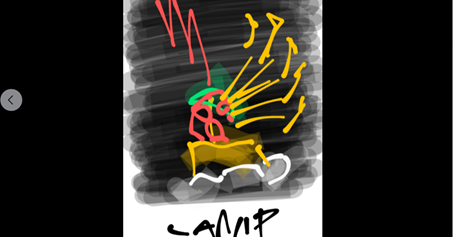
because I was convinced it was real, it occurred on a higher plane than any other dream I have had recently. That is, I was in a mesmeric half-waking state, equivalent to vigilogogy, with a bounce to syngogy. But it made me wonder, the fact that it was so fateful. Perhaps, in the masquerades of self as ghosts dreamt in and about the bedding, all directionals are “under the bed” to us. There is oblivion, and fear of it, on every side of us, when we sleep. That builds up into a world where one false move and the whole world can explode. I thought it was caused by lightning, I feared that others in the building had had it, that the building was going to burn down. This was a full on haunting. The fire was so intense, it scared me (in the ensuing insomnia I looked at drawings Black Elk made of lightning, which registered). Like Jung, it’s possible I picked up a collective vibe (because there was absolutely no weather last night). When Nerval says that he painted the picture with flowers he is saying he wants an achieropoetoi, a miracle image. These images come on the half-waking, half-life syngogic scrying level of mesmeric sleep, setting up further rrhexis (explosive rupture). I would say in general then that Nerval’s imagination has a reverse agency tendency, always seeking by magic to turn it back into reality.
The fact that he at one point describes this project of his thousands of drawings almost in the same way as I describe my own such work, encyclopedic in nature, and it involves a recursive calendered logic, at bottom, to fold the years into one, is uncanny and a bit chilling. It suggests a mania, but as if by a diaristic form of artistic ideation overcovered in art. Consider. Literalism often intrudes upon the full understanding of these things. It is said that Joseph Yoakum, a former go-fer working for circuses his whole life, travelled the world. Then, one day, when he was 73, a dream told him to draw. It is now said that he then took all that he learned travelling the world and poured it into panoramic if primitive landscapes of the wonders he had seen. No he didn’t. His mind got centered or caught in a certain psychodynamic spin, and then it stalled there, recurring, over and over and over again. Each day it is if in his monitoring art, diaristic taking the temperature of the day, his mind as if recorded a graph of psychodynamic energy or not, much like the Seeress did with her sunsphere every morning at seven am, and then he simply overcovered that particular psychodynamic graph which one of his calming landscape, to plough it under, to calm him down. This is exactly what Ronay is doing, he even says he does his work to calm himself down. This is exactly what Nerval is describing here, what I call a Morning Storm, experienced after the Night Mirror, in a mania of anthems, to capture in full the fullness of his life. The fact that he wants to be encyclopedic, and I now acknowledge that quantity over quality impulse is the prime defense mechanism of my life as a sequitur, and I alone have a secret glee in my RoMMerreviews reviews for having fulfilled a desire to do some encyclopedic type work in my time on earth, I mean, Diderot’s dictionary, Johnson’s dictionary, the typologies of Paris, the encyclopedia has always interested me, suggests as well that he is afflicted by a loss that he is seeking to redress in a half life state, in repetition and quantity over choice quality. And another way to put a recursion; attacked by another four o clock demon last night my chest felt tight, so I decided that I had quit abuterol too cold turkey so took a puff to relieve. And when I looked up how long it takes to get the med out of my system, it said, “it takes about six hours for your body to get rid of half of a dose of albuterol, it usually takes about five half-lives for the drug to leave you system entirely. For Albuterol this means that the drug will stay in your system for about 30 hours after your last dose.” This all but models the recursive returns to a site as things slowly fizzle out.
In the text of the edition of Nerval I read, Ross Woodman’s theory is mentioned. (Woodman, 2005, Sanity, Madness, Transformation, The psyche in Romanticism, Univ of Toronto Press). Nerval was asked by his clinician to write Aurelia, thinking that if a narrator named “I’ recounted his experience that might calm his madness. The Red Book by Jung is written for the same purpose, by narrating an “I” one can signify one’s way out of madness. Woodman describes this as learning to “inhabit oneself as a fiction,” arguing that while Wordsworth failed at this, Blake succeeded, and made, by the way, greater art. This offers a different model of fullness of mind, that is, that fullness of mind can DERIVE from the capturing of one’s umwelt, and it is that success that allows for the whole of it, thereafter everything just flows out of you, everything is art, you can speak in plain English about a completely other world. In fact, Blake helped me get there, but….this is about worldbuilding, but from the inside out, you live as if the exoagentic god of an entirely reflective universe, and in that worlding one of course echoes the goal of highest clairvoyance in clear seeing, the whole universe mirrored of your soul.
But, again, the sign that Nerval is in trouble is that each time he runs up the mania to this high pitch, it all begins to dissolve, and he crashes. A house of cards is built, in a mania, it runs past him, he falters, then crashes (this sort of boom bust high crash mental culture was endemic in my early years). It is this part of him that comes apart that signals possible schizophrenia.
He then, out of this mania, realizes that this is the hour of his death, so he runs to that. That is, as I graphed out, the spin, in recursion, at last depletes, things fade, then spin out, and he crashes, the black sign, going down.
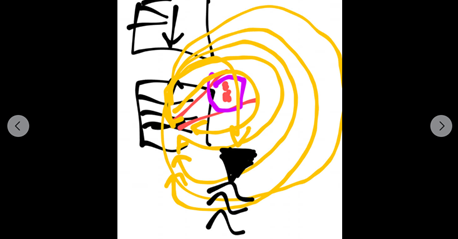
This is when he has his realization of doubleness, which seems horrific to him (more to me, his is a twinfire universe, haunted by the fear that that double is Mr Hyde). It must be assumed that the spin and the heaviness of this recursive spillage, like a rainstorm that stalls over a town, flooding it, this created in his mind a tenderness that at last, as whatever gets heavy on the lattice will, broke through the fabric, and by a violent spin spun him down to the realization that he will die. This is a nightmare formation, third time I think.
After this point, the dreams become much less euphoric, and fata morgana visionary, but sink down into the “real world” of his experience of a dream Paris. To work it out.
At this point, he begins a second journey, where he is possessed, he thinks, by an evil genius. The issue is, Nerval is in the dream moving nicely down through a standard microcosmic world of waking slipping to sleeping, but Abgrunde is not to be encountered until one opens up to hell on earth. Here is where the frustum comes into it. The moderns did not colonize with figures the vigilogogic and hypnagogic states but went straight zero to sixty from consciousness to REM dream state, instantly. That is, they had a different sort of rings of Saturn around these zones, emptying out their finesse.
We pick up at the next sequence…….
At first, he is sliding down on endless tightrope. The earth was burning with volcanoes below. He envisions this as the “spirit world.” This sounds to me like Nerval had occupied the poetic fringes of a solid state conscious world, and yet was vaguely aware of a greater mindspace beyond. I therefore put all the forms of mind between full consciousness and deep REM sleep in dotted line to indicate that they are there, but ghostly, not real, not recognized, and so spirit.
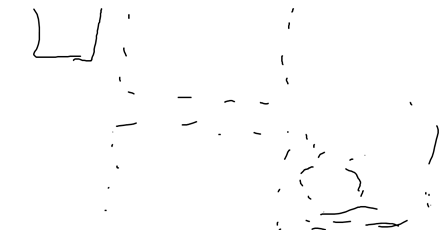
and then, I recognize the tight rope as a circus trope, and as with children’s games, or dunk tanks, I see this as part and parcel of Lucid dream apparati by which one crosses over, but that in this case it slants down from consciousness, and passes over the whole vista of the spirit world below. Something like this.
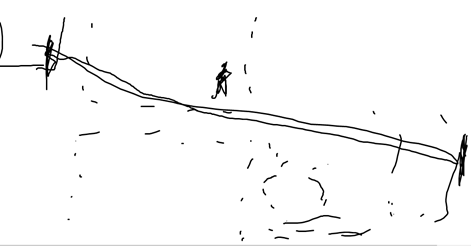
below him, he saw earth, riven by rivers of molten metal, this could be none other than a premonition of hell on earth (I will have another example in Clarke seeing hell on Jupiter), so down there, but he has no bearing on it
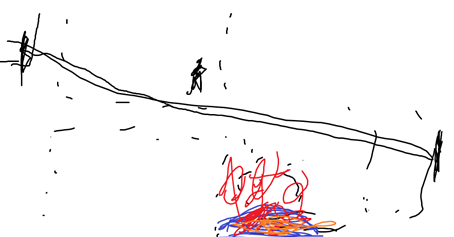
and this then lead to, along his way, obstructions, huge puddles of water suspended like clouds, which he sees as if steam sent up from below, so here
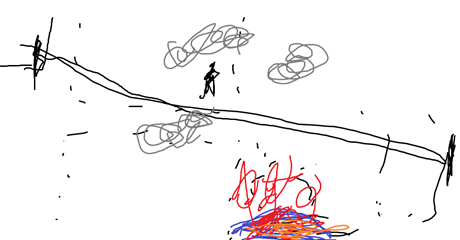
then he comes to a vast beach, a castle on a hill, which he climbs, and then on the other side is a vast city spread out below, something like this.
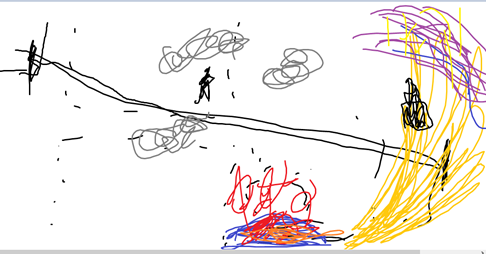
which means that the beach is his metaphor for the crossover point to far sentience, the dark of the mind; then, the castle is, slightly resituated, a trope I know, the Black House, wherein nexi are negotiated, and one crosses over. The city beyond complicates things some, but, situated where it is, and in the prose as it is, it is clearly a fata morgana form cast off the tightrope used as the plumb line of his sanity. But now I have to compress, because that fata morgana city is where he goes, and it seems to be an echo of Paris, entirely floating out in the high fata morgana duct of a vector of vision set off from vacated consciouess. He goes up a dark stairwell to streets, a casino, then there is a workroom, he sees a work of art, “modeling out of clay an encomrous llama shaped animal, which apparently was to be equipped with giant wings,” and it was slowly being brought to life by a beam of fire shot through it. it also had purple blood in its veins, which spoured wool. As such,
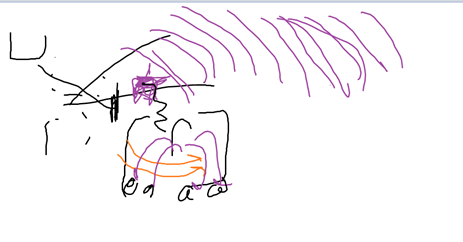
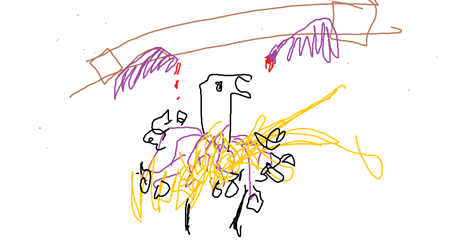
Nerval’s Llama 12 5 21
this “masterpiece whose fabrication seemed to have discovered the secrets of divine creation” is a demon, the question is what kind? If discovered in a trap or kunstkammer in redoubt of psychological space outlying from the fata morgana, it is a wild dream coming down some. Its central downward trajectory is conveyed by its long neck, then, the fire shooting through it is ambient spin, and then the purple veins which sprout wool, and it will have wings, is latticelike dream generation, As a scrirpograph, this could be construed as a llama
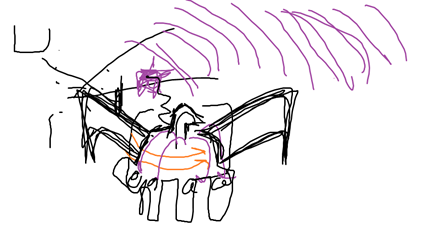
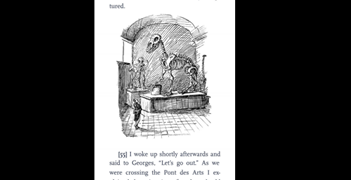
at present, though he reads it miraculously, it exists in overall mindspace in sentience near to and perhaps as a familiar of Psallictus (the god of carnage) himself, thus, he is a harbinger of schizophrenia, warning him, if those wings are attached, things will come apart.
Then he goes back into the castle, and into a throne room, the throne strikes him as amazing, this is a backward step,
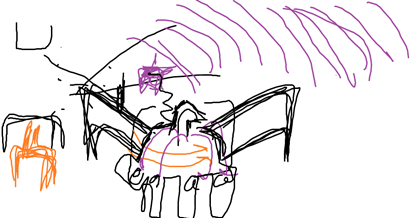
this IS a picture of it, by Kubin, it is a big empty thing, everyone is trying it out, but then he has a complete fit of rage because he imagined that this was a wedding and everyone was awaiting his own double, who was due to marry Aurelia. He screams at everyone, there is trouble, he wakes up.
He is carried from dream back to life by the syllables of some unknown word, not yet pronounced, and it dies on his lips. What’s going on here? He envisioned in this dream the spirit world as existing outside and adjacent to his world, and inhabited by demons, one of whom might represent a warning of onset of breaking up. In its throne room however he realizes that this is yet his mind, and the figure in the scene therefore is his double. This is a doppelganger zone, superimposed upon an empty perception of ambient and sentient dream space. He falls out of the dream, by the throne, as if overthroning him
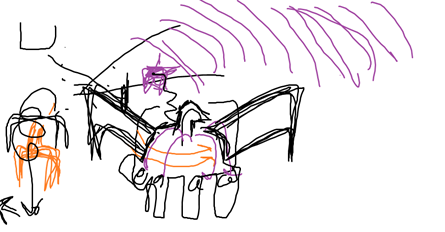
Thus, we have two worlds, as mapped out, the real world, Paris of his consciousness, which is there, and then its double in whole, a mirror world, the spirit world, occupying all of ambient and sentient space, mirroring the other.
Taking all poetic states to be vigilogogic I will argue that my whole vigil-hypnagogic zone is, for him, a representation of “real” Paris, and that, then, it is mirrored, in the unseen ambient and sentient space beyond, by Dream Paris, the Mystic city, and they interact in a loop
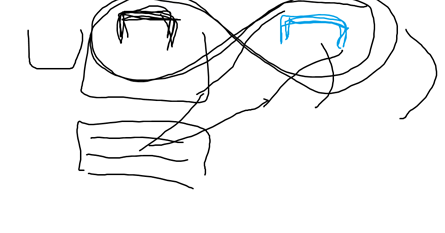
in this new state, however, and this would be the purpose of the dream, to accustom him to it, he has a new power, a kind of clairvoyance, he hears a woman scream, but he says, to my mind terrestial events were bound up with those of the invisible world, admitting that he does not quite understand these strange relations, how it works is, he hears the scream, then he hears it echo in the spirit world, as such
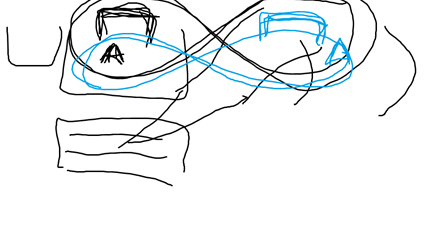
this creates a tremor, or frisson, or nomos, sent through the whole of Paris, and it so scares him that he thinks that this perturbationi will destroy the link, “had I disturbed the harmony of that magical universe, from which my soul drew the certainty of immortal life. Perhaps I was accursed for having attempted to penetrate into a terrible mystery in violation of the divine,” So, secondarily, in addition to being the spirit world, that is heaven, or the world of the immortals which he, as a catholic, hopes by faith to ascend to upon death. Now, he is not so sure, and it is shaking him up. Then, he even thinks, so it recoiling negatively upon him, it might attack him, he fears that because he made that tight rope walk he is accursed, he saw and learned things that he should not have.
At another point he posits that God rules over this world, Jesus, but then also seems to acknowledge further out, the god of Lucretius, who is so immense that he is effectively powerless. This is a god that “did not admit of a singular royalty.” So, it is not simply that the spirit world is a catholic world, but that he has split it off from the church and has been populating it in recoil with his own beliefs. He then speaks to a poet who gives him a good dose of all these “god is everything” spells, and this casts him into another phthsis.
It is at this point that Kubin provides a provocative picture, a man as if almost, but not quite, crawling, maybe, out of bed. If he is getting up in the morning it is with reluctance and it is not going to be a nice day. I suppose the intent was to show the effect of depression over a specific problem, what it feels like to wake up again to an unresolved crisis, making you immediately want to go back to sleep. This is a proskeynetic pose, indicating lack of energy, a heaviness, and unwillingness. It is a Not Wanting to Live, Not Wanting to get up demon, nice shot. It could also be the four o clock demon, who depletes things to nothing.
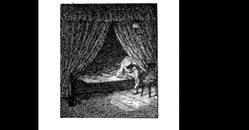
end of part one.